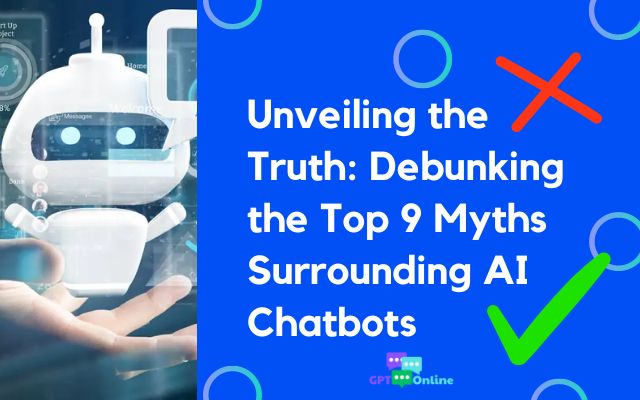AI chatbots have taken the world by storm, revolutionizing the way we interact with technology. However, with such rapid advancements comes a flurry of misconceptions and controversies. In this article, we dive deep into the realm of AI chatbots, separating fact from fiction. Join us on this journey as we debunk the top 9 myths surrounding these fascinating digital entities.

Top 9 Myths Surrounding AI Chatbots
AI Chatbots are Sentient
Let’s start by demystifying the belief that AI chatbots possess sentience. While ChatGPT and Bing Chat may astound us with their human-like responses, they are far from being sentient beings. These chatbots rely on extensive databases of text and images, employing clever algorithms to mimic human interaction. They exhibit intelligence, but it is derived from the massive amounts of data they are trained on, making them more like incredibly powerful databases than conscious entities.
Limitations: Not a Universal Solution
While chatbots can be incredibly versatile, they do have limitations. Handling complex or highly specialized topics can be a challenge for them. Even seemingly straightforward questions can sometimes leave them stumped. For instance, asking ChatGPT about its competitor, Google Bard exposes the limitations of its knowledge. Chatbots are continuously evolving, but they are not omnipotent problem solvers.
Threat to Humanity: Separating Reality from Exaggeration
Let’s dispel the notion that AI chatbots pose a threat to humanity as a whole. While they may disrupt certain industries and impact job markets, it would be an exaggeration to claim they are a universal menace. We must vigilantly monitor AI’s ethical implications, ensuring it remains a safe and responsible technology. However, the dystopian vision of chatbots dominating the world is far from reality.
Fallibility: Unmasking the Imperfections
Contrary to popular belief, chatbots are not infallible. It’s crucial to recognize that they operate based on large language models (LLMs), which contain data from a myriad of sources. These vast databases are susceptible to factual errors, leading chatbots to occasionally provide incorrect information. AI hallucinations are a prime example of the fallibility of these systems.
Human Interaction: Embracing the Nuances
Human interaction is a complex tapestry of emotions, experiences, and intricate nuances that AI chatbots cannot fully grasp. While they can provide factual responses and assist with certain tasks, they lack empathy, critical thinking, emotional understanding, and intuition. The depth and richness of human interaction cannot be replicated by AI alone.
Multimodal Capabilities: Beyond Text Interactions
The notion that AI generative chatbots are limited to text interactions is outdated. Recent advancements have propelled chatbots into the realm of multimodal capabilities. These cutting-edge chatbots can now seamlessly handle not only text but also images, videos, and even voice commands. The rapid pace of innovation is pushing the boundaries of what these chatbots can achieve.
Bias: The Challenge of Unbiased Responses
While developers strive to minimize biases in chatbot responses, eliminating them entirely remains a formidable challenge. Bias can inadvertently seep into chatbot interactions due to the biases present in the data they reference. The journey toward unbiased responses is ongoing, and as AI evolves, techniques to reduce bias will improve.
The Human Behind the Bot: Dispelling the Conspiracy
Let’s address the most ludicrous myth of all—the belief that real humans operate behind AI chatbots. This unfounded conspiracy theory has no basis in reality. AI chatbots are sophisticated automated systems designed to mimic human-like conversation, but they operate independently without direct human involvement.
Self-Programming Abilities: Human Intervention Required
Contrary to popular belief, chatbots cannot program themselves autonomously. While they leverage machine learning techniques to enhance their performance, human intervention, and programming expertise are still crucial. The training process for chatbots is akin to the testing process of non-AI software, requiring the definition of objectives, and architectural design, and teaching them to generate responses based on the data in their respective LLMs.
Conclusion
In a world where misinformation often runs rampant, it is essential to separate fact from fiction when it comes to AI chatbots. These digital marvels have come a long way, but they are not without limitations. Understanding the true capabilities and boundaries of AI chatbots empowers us to harness their potential while avoiding unrealistic expectations. As we continue to explore the vast possibilities of AI, let us dispel myths and foster a more informed understanding of this groundbreaking technology.